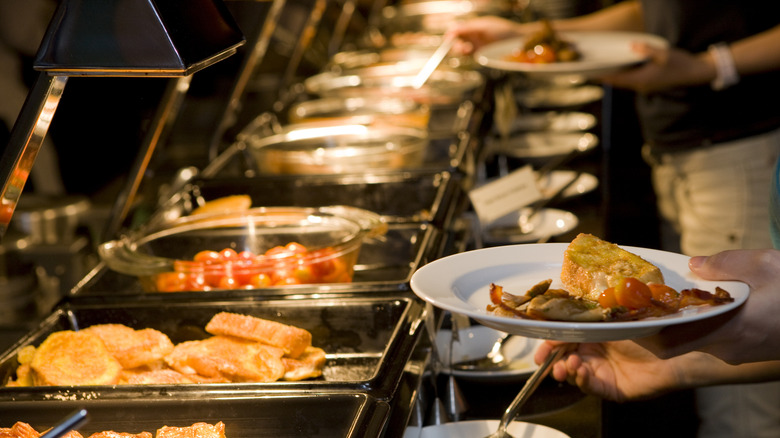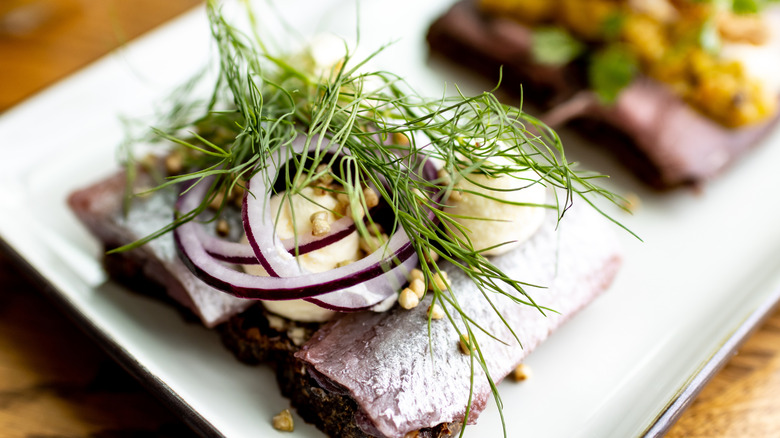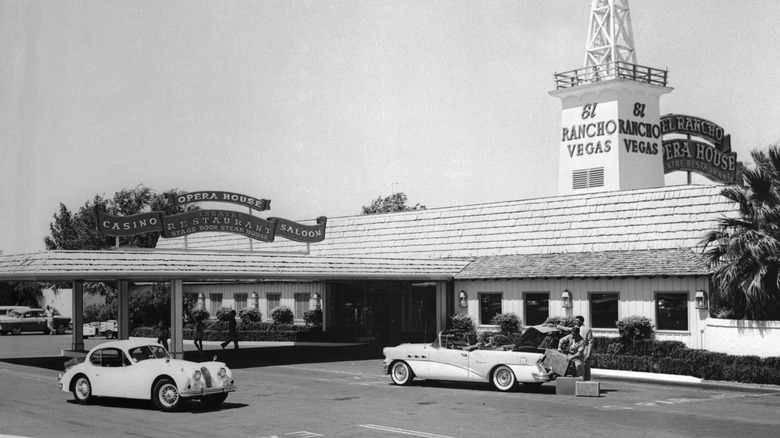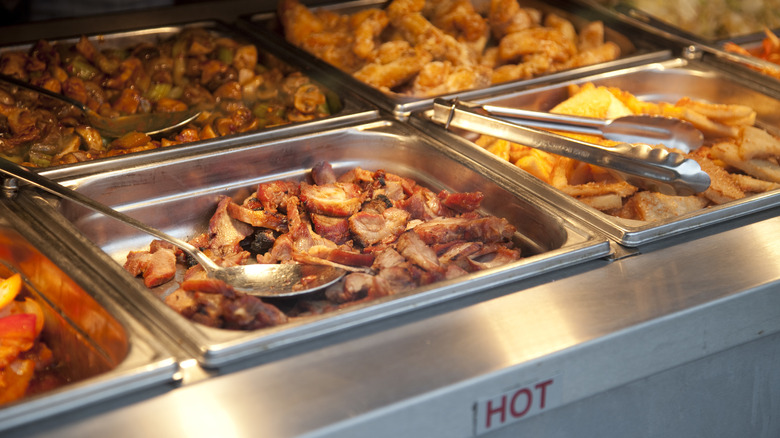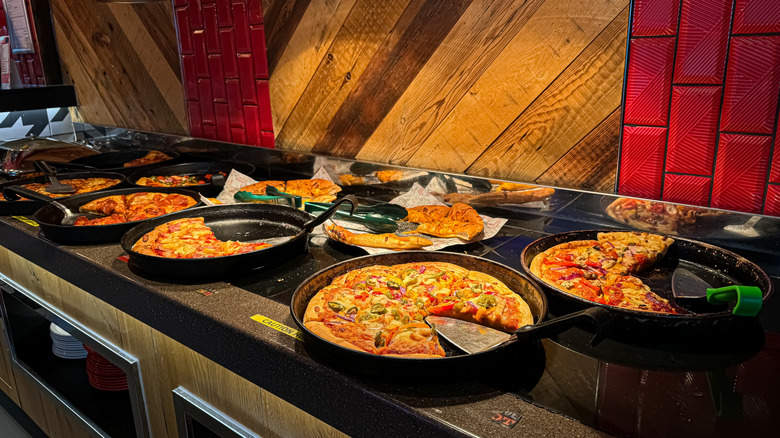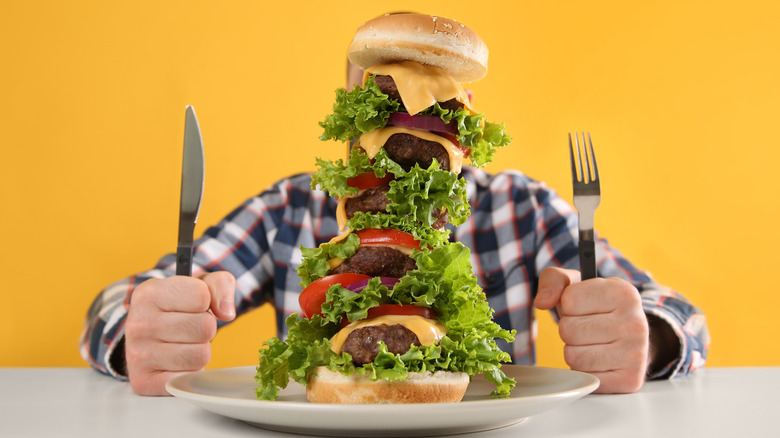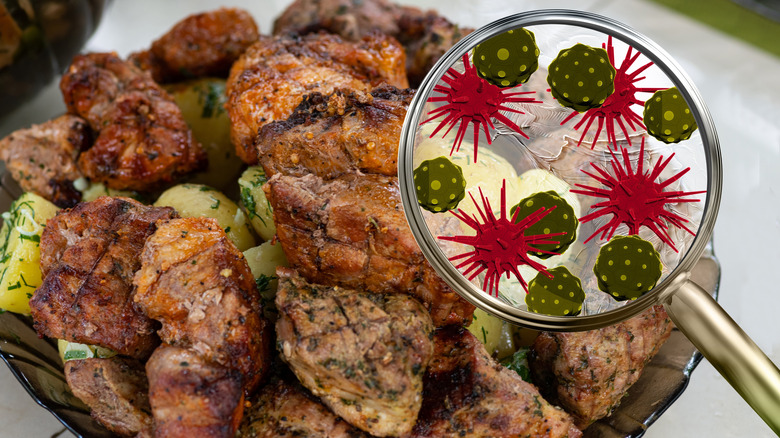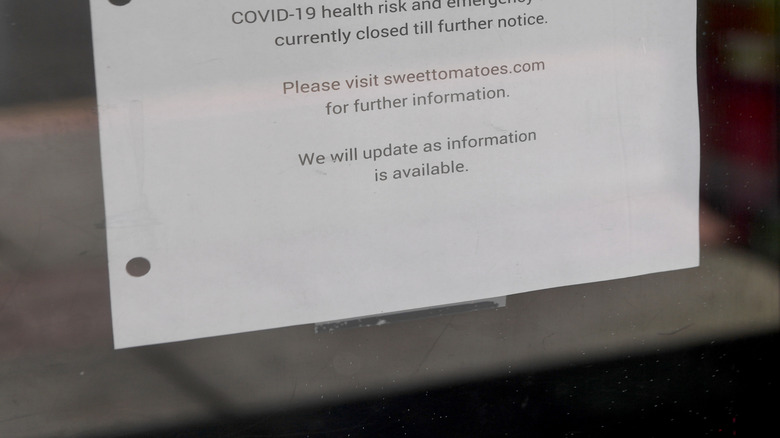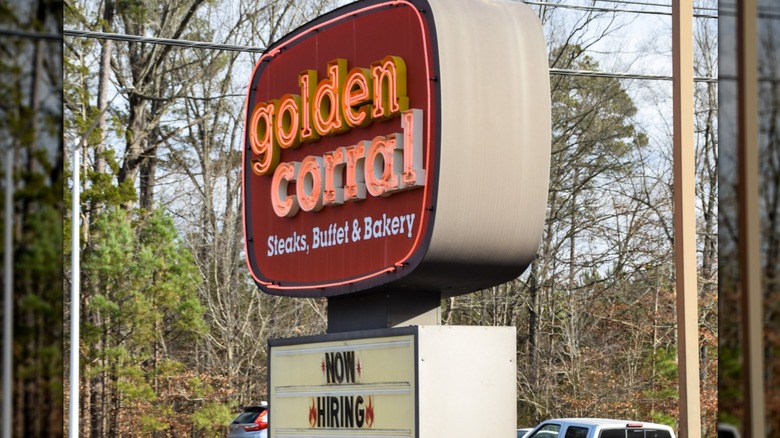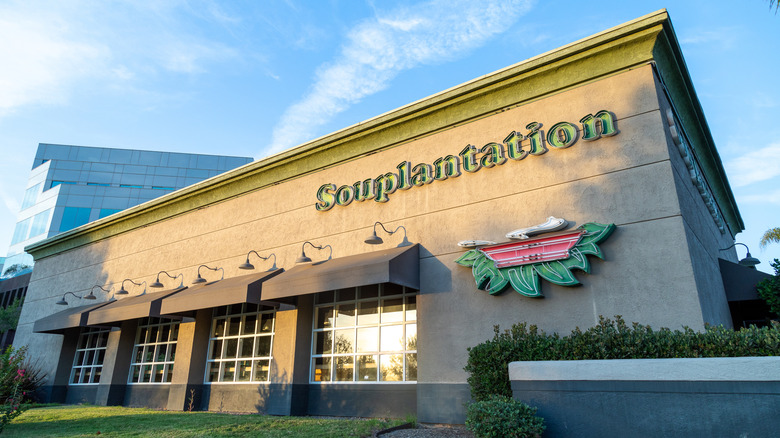The Rise & Fall & Resurgence Of Buffet Chain Restaurants
The buffet restaurant is a mainstay of U.S. dining, and chances are you've been to at least one in your lifetime. While they might seem ubiquitous, their numbers have ebbed and flowed over the years. These marvels of overconsumption were once one of the more popular models for restaurants in the country; not only were entire chains devoted to the model, but other restaurants had their own mini-buffets, and even fast food restaurants wanted a piece of that buffet action. Over the past few decades, buffets have seen some difficult years, and the COVID-19 pandemic dealt the industry a near-fatal blow.
But buffet chain restaurants have been making a comeback. Some all-you-can-eat (AYCE) buffets have reportedly seen hours-long lines. While the scene still looks very different from what it was like five, 20, and definitely 40 years ago, the number of buffet chain restaurant franchises is actually growing in some cases. Customers are flocking to reopened favorites and copycats that promise to mimic long-gone buffets. How long this current rise will last is anyone's guess, but for buffet fans, the current scene is doing very well compared to just a couple of years ago. Here's a look at the rise and fall — and resurgence — of buffet chains.
Buffets have been around since the 16th century
The concept of a buffet isn't new at all, and the first buffet-style meals on record were served in the 16th century. These were meals known as brännvinsbord, a Swedish tradition meant to give guests something to nibble on before a bigger feast. These meals had a selection of cheese, bread, meat, butter, and other small dishes. The brännvinsbord gave way to the smorgasbord in the 18th century, which was essentially the brännvinsbord as a full meal. The smorgasbord eventually went international at the 1939 World's Fair in New York.
The smorgasbord does have a big difference from the buffets that eventually opened up in the U.S., and that's because the Swedish tradition has rules about what you get and what order. The smorgasbord is also definitely Swedish with an emphasis on Swedish cuisine, while buffets are basically whatever the restaurant management wants them to be. A buffet gives you a chance to sample what you want, when you want, and it does not have the restrained, planned experience that a smorgasbord aims to provide.
The American buffet restaurant was born in Vegas
The huge spreads you think of today when you see a buffet had more humble beginnings in the mid-1940s; a hungry hotel and casino employee was making a sandwich out of cold cuts, and some gamblers passing by mentioned how hungry they were. That employee was Herb McDonald, who worked at El Rancho Vegas. He supposedly brought out more food for the gamblers — not a full meal as they couldn't gamble and eat at the same time. That turned into the "Buckaroo Buffet," a 24-hour AYCE buffet that was so cheap and convenient that gamblers stayed at the resort instead of heading out somewhere else to get late-night meals.
The concept of the buffet expanded not only in size but in location, as more hotels and casinos opened up their own versions. Las Vegas soon became known for its buffets, which ranged from the inexpensive quell-the-hunger types to very high-end and expensive buffets where you went specifically for the food, and not just the feeling of being full. Buffets spread across the country, helped along by the emergence of Chinese buffets in the '50s and '60s. By the 1970s, buffets — Vegas, Chinese, or otherwise — had become hugely popular and a regular part of dining out for many in the U.S.
The 1970s and 1980s were buffet restaurant heydays
Buffets had grown into a nationwide phenomenon by the 1970s and 1980s as restaurants discovered how many customers they could draw in without increasing costs too much. Customers loved the buffets because of the affordable prices and the fact that their picky family members could all find something they wanted to eat without arguing.
Part of the success also had to do with the times. The '70s, '80s, and even the '90s were known for consumer excess. The idea of a buffet where you could take what you want from this outrageously large spread of every conceivable dish (okay, not really every dish, but a lot) fit perfectly into what people expected at the time. Unfortunately, the rapid growth of buffets meant that eventually, there were no other customers to draw in except your competitors' customers. People didn't go to a buffet because it was the only one in town. They went to a buffet because they wanted to go to that specific place, while all the other buffets in the area did not get their business.
Buffets became so popular that even fast food restaurants tried them
If you run a business and see a competitor doing something that people like, you're going to try something similar, right? That's what fast food restaurants did when they saw how popular buffets had become. Companies from KFC to Wendy's opened up their versions of buffets inside their restaurants, and to this day, many people who grew up going to Wendy's Superbar or another fast food buffet have fond memories of pizza galore and fast food Mexican extravaganzas. Most of the buffets didn't last long as a whole; Wendy's Superbar, for example, lasted about 10 years. Some fast food buffets supposedly still exist, however. KFC still has buffets in countries like Australia and Japan, and there are anecdotal reports of KFC buffets still in operation as of 2024 in Southern states such as Tennessee and Kentucky.
Some buffets, though, live on in memory for some people, but evidence is hard to find that they actually existed. Many people have memories of eating at a McDonald's breakfast buffet or getting huge quantities of food at AYCE Taco Bell buffets. Yet others don't, and even spokespeople at the companies have supposedly been rather vague when asked. Regardless of whether these buffets did exist or not, though, the brief period of time when fast food buffets were the norm remains a treasured memory for a lot of people.
Buffet chains barely broke even when times were good
Buffet restaurants have surprisingly thin margins despite their ability to cut back on waitstaff labor costs. They don't have to have people bring food to you like in non-buffet restaurants, and their menus can focus on cheaper foods because the sheer variety of options often makes up for having a smaller number of super-expensive foods. But buffet restaurants need a lot of that cheaper food. So, while the basic cost of each food might not be high, the cumulative cost can be enormous.
Even if the people eating at the buffet aren't going back for seconds and thirds, the turnover of items at the buffet just to ensure food safety means that kitchen has to cook and cook and cook. Plus, people often take more food than they can finish, resulting in buffet dishes needing replenishment. That means that even when times are good and the buffet chain is making a profit, it's generally a tiny one.
Buffets do what they can to minimize costs both behind the scenes and at the point of purchase for the customer. For example, they'll buy in bulk and concentrate on those less-expensive items like vegetables or cheaper forms of meat. All of that has helped the restaurants try to stay afloat over the years, although it wasn't always successful.
The restaurants try to control food waste and heavy eaters
Two issues make it harder for buffet chain restaurants to survive. One is wasted food, and the other is the phenomenon of heavy eaters. Kitchens have to use more food and spend more money to refill empty buffet trays, and that cuts into what money the restaurant can use toward keeping its doors open during periods of slower business. Some chains have added fees to take home leftovers; others have looked at policies requiring customers to clean their plates before getting more food. Many buffets in Europe actually charge a fee if you don't finish what's on your plate.
Another issue that buffets have faced repeatedly are those heavy eaters. Many times, one heavy eater's large meal is countered by several other customers taking smaller amounts of food (and cheaper food at that). This type of variation is something buffet restaurants expect. But they still need to make sure that they aren't inadvertently helping the heavy eaters grab more of the expensive food. Buffet chains will do everything from using smaller serving utensils with more expensive food to using smaller plates.
Buffet chains were already in trouble before 2020
We'll get to the pandemic in a moment, but let's talk about the 2000s and 2010s first. Those decades saw buffet chains suffer from some real financial problems. From Ponderosa to Old Country Buffet to Souplantation, parent companies filed for bankruptcy — one company, Ovation Brands, filed two more times by 2016 after taking on tremendous debt. Many chains closed a large number of locations as a result. But the bankruptcies weren't the main cause of the chains' problems; they were a result. The problems leading to the financial issues were many, and some of them may have you eyeing buffet food warily.
In some cases, the restaurants just didn't plan well, with customers taking more of those expensive foods than the restaurants had planned on. This isn't that much of a problem when there's a limit to what people can physically eat, but it does happen sometimes. The Great Recession in 2007-2009 also took down a few chains. Many buffet chains also had issues with food safety, ranging from contamination with bacteria to contamination with rat poison, as was the case in two salad bars in Australia in 2006. Another issue was that people's tastes were changing from wanting pans full of comfort food to more upscale options. By 2019, the landscape already didn't look that great for buffet chains in general.
The pandemic was a major turning point
The onset of the pandemic in 2020 was a huge and devastating turning point for many buffets. Even Las Vegas' famous AYCE buffets were on shaky ground in the first few months, with restaurants scrambling to find ways to accommodate personal and community safety, while also allowing people to continue to eat. As you can guess, a ton of buffets had to close. Chains around the country reported sales numbers that were only a small fraction of what they had been pre-pandemic; for example, one buffet restaurant in Washington, D.C. told the BBC that their business was down by 90% four months into the pandemic after a two-month closure.
Initially, no one knew what would happen. Many Vegas buffets tried to stay open, but the absence of guests was already noticeable even in March 2020. That month, some resort operators announced temporary closures while others tried to promote hygiene measures like using hand sanitizers and increasing how much cleaning their staff carried out. By May 2020, chains were closing permanently, including some nationwide chains with devoted customer bases. Since then, many buffets have returned, but the AYCE buffet landscape looks very different than how it did before the pandemic, even during those tougher years of the 2010s.
Golden Corral and Shady Maple galloped off in different strategic directions
While many buffet chain restaurants suffered and closed during the pandemic, two sped off in different directions. The managements of both chains were determined to survive, and they knew they needed different strategies. One of these chains is Golden Corral; the corporate offices worked with franchise owners to determine ways to move forward. One change was company-wide; Golden Corral began serving food cafeteria-style, with employees dishing up food for customers. Golden Corral also focused on adapting to meet local regulations with the help of those local governments. If franchisees had suggestions, the corporate offices listened. The results were extremely beneficial for the chain as the number of its franchises is growing, and the company was named #63 for 2023 on Franchise Times' annual ranking of franchises.
Shady Maple Smorgasbord is the other company that tried something new. It initially had to close, as did most other restaurants, and then it went through a series of reopenings and closings as the pandemic progressed. When the restaurant was open, it switched to a to-go menu, but it also leaned heavily onto its attached grocery store. Since then, the restaurant has seen very positive growth as people seek it out because they view its food as fresh and affordable.
Nostalgia for specific chains grew strong
When your favorite restaurant closes, sometimes your nostalgia for them only grows. That's something that's helped the buffet restaurant industry rise again from the chaos of the pandemic as nostalgia for specific chains has led to attempts of reopening. Souplantation, known as Sweet Tomatoes in states other than California, is a prime example. The buffet chain closed completely in May 2020 essentially because the management couldn't figure out how to create a sustainable business model when no one could (or would) take food from a communal table that was only partially protected by a sneeze guard.
In May 2022, a man in La Mesa, California claimed he would reopen one Souplantation location. Dmitry Braverman planned to link the restaurant to an adult day care center, with the restaurant reserved for that community at some hours and open to the public at others. He reportedly had the support of some former Souplantation employees, too. By August 2022, Braverman had encountered problems with fire inspections, and getting rights to the Souplantation name from a Florida company that had bought those rights in 2021. Unfortunately, Braverman's attempt to reopen Souplantation eventually failed. However, in April 2024, that company in Florida reopened a Sweet Tomatoes location in Tucson, Arizona, and a copycat chain called Soup 'n Fresh had a soft opening in Rancho Cucamonga, California in February 2024. Both have developed enthusiastic customer bases, and the company running Sweet Tomatoes has hinted at expansion.
Inflation actually benefited the buffet
One of the unexpected reasons why buffet restaurants, especially AYCE models, are once again surging in popularity is the fact that they're comparatively cheap given the amount of food you can get. Inflation has been a problem for everyone, everywhere; even fast food prices have become problematic, with almost 80% of Americans claiming fast food is too expensive as of a May 2024 survey by LendingTree. While some buffets are considered high-end and have very high prices, others have prices that harken back to pre-pandemic days. If you're really hungry and aren't sure exactly what you want to eat, or you have a family unable to agree on which type of food to get for a meal, a buffet for under $15 or $20 per person seems like a godsend.
It doesn't hurt the existing chains that so many other buffets went under during the height of the pandemic. All those customers looking for a deal now have fewer buffets to choose from, so the remaining ones benefit as more customers head their way. There's been some speculation, too, that in an age of inflation, seeing all that food on table after table is very tempting and a welcome sight. Plus, you can get whatever you want from those piles of food! Wouldn't you want to have that experience if you've been on a tight budget? For people struggling with the cost of living, an AYCE buffet dinner that offers such abundance quickly becomes a favorite.
